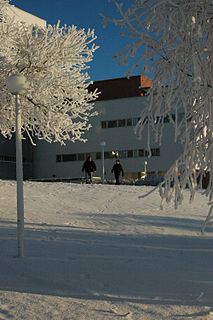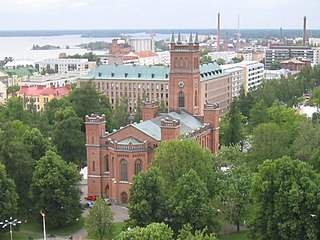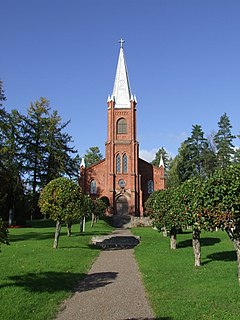
Carl Axel Setterberg (1812-1871) was a Swedish-born Finnish architect. Setterberg provided much of the urban design for the city of Vaasa, Finland. [1]

Carl Axel Setterberg (1812-1871) was a Swedish-born Finnish architect. Setterberg provided much of the urban design for the city of Vaasa, Finland. [1]

Setterberg was born at Bogsta parish in Södermanland, Sweden. He studied to become an architect at the Royal Swedish Academy of Fine Arts in Stockholm from 1834–1841. In May 1841, he got a job as building contractor in Gävleborg province, where he worked the following ten years. In this position he led many important building projects in Gävle and designed several public buildings.
When he heard that the city of Vaasa in Finland had burned down to the ground in 1852, he became interested in the opportunities surrounding the rebuilding of the city. He travelled to Vaasa where the job as county architect was open, and in January 1853 he was temporarily appointed for the job after impressing the county governor Berndt Federley (1799–1863). In 1855, he permanently became county architect after he had becoming citizen of the Grand Duchy of Finland. [2]
In 1854, he became the city architect and was commissioned with drawing up the new city plan on the isthmus of Klemetsö, about seven kilometres (4.3 miles) to the northwest from the old town. The new town of Nikolaistad (Finnish: Nikolainkaupunki), named after the late Tsar Nicholas I, rose in 1862. The new city had a modern square layout and was divided by wide streets. Setterberg also designed many of the city's public and private buildings. In 1871, Setterberg died at Nikolaistad (renamed Vaasa during 1917). [3]
In year 2000, Setterberg was voted the most significant person from Vaasa of all time. The poll was a part of Vaasa's 400th anniversary celebration. [4] [5]

Helsinki is the capital, primate, and most populous city of Finland. Located on the shore of the Gulf of Finland, it is the seat of the region of Uusimaa in southern Finland, and has a population of 656,250. The city's urban area has a population of 1,268,296, making it by far the most populous urban area in Finland as well as the country's most important center for politics, education, finance, culture, and research; while Tampere in the Pirkanmaa region, located 179 kilometres (111 mi) to the north from Helsinki, is the second largest urban area in Finland. Helsinki is located 80 kilometres (50 mi) north of Tallinn, Estonia, 400 km (250 mi) east of Stockholm, Sweden, and 300 km (190 mi) west of Saint Petersburg, Russia. It has close historical ties with these three cities.

Åbo Akademi University is the only exclusively Swedish language multi-faculty university in Finland. It is located mainly in Turku but has also activities in Vaasa. Åbo Akademi should not be confused with the Royal Academy of Åbo, which was founded in 1640, but moved to Helsinki after the Turku fire of 1827 and is today known as the University of Helsinki.

The Governor, Maaherra, or Landshövding, of a province of Finland headed the activities of the State Provincial Office, Lääninhallitus, or Länsstyrelse until the end of 2009, when the provinces were abolished. The governors were appointed by the President. Many former ministers including but not limited to Kaarlo Hillilä, Martti Miettunen, Hannele Pokka and Anneli Taina served as governors, since the post was regarded as prestigious enough for a retiring minister, but still politically neutral. The title of maaherra was also considered a personal title, such that once appointed, the title maaherra remained for life.
The Province of Vaasa was a province of Finland, established in 1775 when Finland was an integrated part of Sweden from the southern part of Ostrobothnia County and disbanded in 1996. The province was named after the city of Vaasa.
Turku and Pori Province was a province of independent Finland from 1917 to 1997. The province was however founded as a county in 1634 when today's Finland was an integrated part of Sweden. It is named after the cities of Turku and Pori.
The Bank of Finland is the central bank of Finland. It is the fourth oldest central bank in the world.

The University of Vaasa is a multidisciplinary, business-oriented university in Vaasa, Finland. The campus of the university is situated by the Gulf of Bothnia adjacent to downtown Vaasa. The university has evolved from a school of economics founded in 1968 to a university consisting of four different schools: The School of Accounting and Finance, The School of Management, The School of Marketing and Communications and the School of Technology and Innovations. University of Vaasa is one of the largest business universities in Finland. The university has personnel of around 500 which includes a teaching staff of 180 and 54 professors. Around 5000 students are currently studying in various degree programs at the university.

Korsholm Church is a church building in the city of Vaasa, in the region of Österbotten in Finland.

Robert Wilhelm Ekman, a.k.a.R. W. Ekman, was a significant teacher and painter of the Finnish romantic portraits and early national romanticism.
The Province of Häme was a province of Finland from 1831 to 1997.
Grönvik glasbruk or simply Grönvik was a glassworks in the present-day Grönvik village in Korsholm, Western Finland. It was founded by merchant Johan Grönberg and existed from 1812 to 1907. Several glass manufactures were produced at Grönvik. At first bottles and drinking-glass were made here, but beginning in the 1890s solely window glass. Also pharmaceutical glass was manufactured. The glassworks produced as the first factory in Finland pressed glass, which came about from the 1840s. The domestic market for glass was during the time of the glassworks smallish and glassblowing products were exported to e.g. Lübeck, Saint Petersburg, Stockholm and Denmark, as well as to other parts of Europe. Grönvik was able to successfully assert its position, despite the competition from other glassworks in Finland. Eventually, it became the most distinguished in the country. The glassworks also become the largest in the Nordic countries.

Vaasa, in the years 1855–1917 as Nikolainkaupunki, is a city on the west coast of Finland. It received its charter in 1606, during the reign of Charles IX of Sweden and is named after the Royal House of Vasa. Vaasa has a population of 67,447, and is the regional capital of Ostrobothnia. Vaasa is also well-known as a major university and college city in Finland.

Olof Samuel Tempelman was a Swedish architect and, from 1779, professor at the Royal Swedish Academy of Arts. He was appointed royal architect in 1799.

Berndt Abraham Godenhjelm was a Finnish painter.

Carl Johan von Heideken was a Swedish architect who made his career in Finland.

Defence Command, organized as Headquarters during wartime, is the joint command headquarters of the Finnish Defence Forces and a central government agency. Active since 1918, it leads and monitors the execution of the duties prescribed to the Defence Forces, such as the military defence of Finland.

Fabianinkatu 17 is a national romantic-art nouveau building in central Helsinki. Built in 1900–1901 to a design by the architectural firm of Gesellius, Lindgren and Saarinen, it was originally a block of flats, but became increasingly used for offices and was for many years known as the Doctors' House. In 1953 Agronomiliitto, the Finnish Association of Agronomists, bought it, and it is now called Agronomitalo.
Wasa theatre is a professional Swedish-language theatre in the Finnish city of Vaasa. It is the regional theatre of Österbotten and was founded in 1919.
The Finnish Customs is the customs service of Finland. It is a government agency steered by the Ministry of Finance. Finnish Customs is a part of the customs system of the European Union. Finnish Customs has around 1 900 employees.

The Tampere Central Fire Station is a fire station located at Satakunnankatu 16 in the Jussinkylä, Tampere, Finland, on the eastern shore of Tammerkoski. The Art Nouveau-style fire station building, completed in 1908, was designed by architect Wivi Lönn.